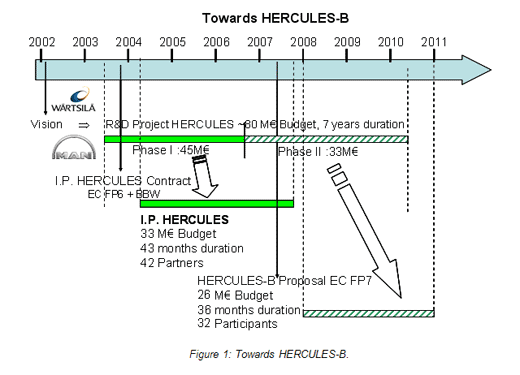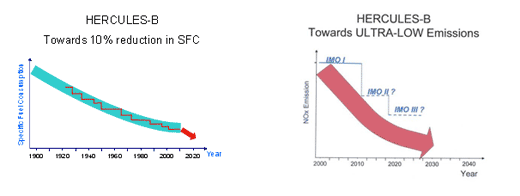| Concept and objectives
HERCULES was conceived in 2002 as a 7 year R&D Programme, of 80M€ budget, to develop new technologies for marine engines:
- To increase engine efficiency, thus reduce fuel consumption and CO2 emissions.
- To reduce gaseous & particulate emissions.
The R&D Programme HERCULES is the outcome of a joint vision by the two major European engine manufacturer Groups MAN & WARTSILA, which together hold 90% of the world's marine engine market.
It was the first time that these two Groups participated together in a project with commonly defined Research Areas.
Phase I of the Programme HERCULES materialized as the FP6 Integrated Project "I.P. HERCULES" jointly funded by the E.C. and Swiss Government, as shown in Figure 1 below.
The I.P. HERCULES (A) structure of work comprised 54 subprojects, grouped into 18 Tasks and 9 Workpackages, spanning almost the complete spectrum of marine engine technology. The duration of I.P. HERCULES (A) was 43 months, up to September 2007.

The present Project HERCULES-B is the Phase II of the original 7-year Programme concept. The general targets for emissions and fuel consumption are retained in HERCULES-B. However, based on the developed know-how and results of I.P. HERCULES (A), it is possible to narrow down the search area, to focus on potential breakthrough research and to further develop the most promising techniques.
The general targets for HERCULES-B are more specific, are consistent with the overall 7-year plan of the HERCULES Programme, are ambitious yet realistic, in view of the successful results of I.P. HERCULES (A) and are the following overall targets with respect to economy and environmental impact of marine engines.

The HERCULES-B is a large scale project, integrating technologies in ALL the significant areas of marine diesel engine development. Specific measurable/verifiable Objectives have been set, related to each Workpackage, to serve as Indicators of accomplishment.
| |
Workpackage Title |
Representative Objectives (achievable within the Project) |
| WP 1 |
Extreme parameter engines |
- 2-S engine, PMAX: 220 bar, Mean piston speed: 10 m/s
- 4-S engine, PMAX: 300 bar, Mean piston speed: 12 m/s
|
| WP 2 |
Combustion
|
- Transparent cylinder cover with optical access; 2-stroke, 500 mm bore engine, 4-stroke, 320 mm bore engine, firing conditions, 200 bar, 2000o C
- Measured injection and combustion full-scale spatial data, for CFD engine simulation validation
|
| WP 3 |
Turbocharging |
Multistage turbocharging, with 8 bar charging pressure on test engine |
| WP 5 |
Emission reduction methods |
- EGR / CGR / Scrubbing for NOx reduction > 50%, on test.
- Engine application for SCR with fuel of high sulphur content.
|
| WP 6 |
Overall powertrain optimization |
High pressure boiler compounding system, to achieve overall powerplant efficiency 60% on test. |
| WP 7 |
Advanced materials, friction and wear |
Reduction 25% in piston ring friction and guide shoe friction |
| WP 8 |
Electronics and control |
Installation on test engine of intelligent management system with self learning and fault tolerant capabilities and comparison with conventional systems. |
HERCULES - VISION
| Table 8 HERCULES VISION |
Year 2020 |
| Reduction of fuel consumption and CO2 emissions |
-10% |
| Reduction of NOx (Relative to IMO 2000 standard) |
-70% |
| Reduction of other emission components (PM, HC) |
-50% |
Innovation
Some of the areas where innovations are considered in the HERCULES-B Project are:
- Power cylinder technology for "extreme" mechanical and thermal load in marine engines
- In-cylinder measurement, observation, visualization methods for large engines
- "New" combustion concepts
- "Intelligent" variable geometry, multistage, power assisted turbochargers
- "Hot"-operating engine with combined steam cycle
- Exhaust gas recirculation, scrubbing and aftertreatment methods in heavy-fuel engines
- New sensors and emission measurement methods for large engines
- "Low-friction", low wear, piston ring and guide shoe materials for engines.
- "Adaptive" control of marine engines
|